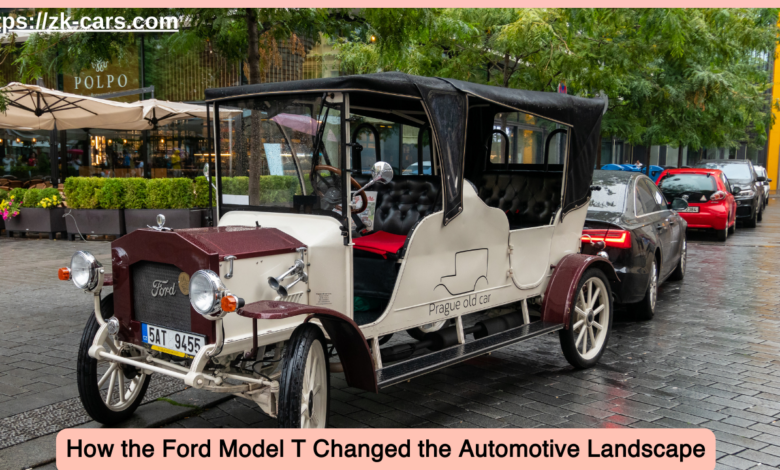
The Ford Model T is more than just a vintage car—it is a symbol of innovation and change in the automotive world. Launched in 1908, the Model T revolutionized car manufacturing, transportation, and how people experienced mobility. It was the first vehicle that was affordable for the average American, paving the way for the automobile to become a mainstream mode of transportation. As the most significant car in automotive history, the Ford Model T didn’t just put people behind the wheel; it changed the entire landscape of transportation, manufacturing, and urban development.
1. The Birth of the Ford Model T
Before the release of the Ford Model T, cars were largely luxury items, available only to the wealthy. Early cars were often hand-built, which made them expensive and inefficient to produce. Henry Ford, the visionary behind the Ford Motor Company, had a different idea. He believed that cars should be accessible to everyone, not just the elite. His goal was to produce a car that was reliable, durable, and affordable for the working class. Thus, the Ford Model T was born.
The Model T’s design prioritized simplicity and functionality. Ford used lightweight yet durable materials, such as vanadium steel, which enhanced the car’s strength without increasing costs. The car’s engine, a 20-horsepower inline-four, was powerful for its time but designed for ease of maintenance and repair. These qualities made the Ford Model T not only affordable but also practical for a broad spectrum of drivers.
2. Revolutionizing Manufacturing: The Assembly Line
One of the key reasons the Ford Model T changed the automotive landscape was the introduction of the assembly line. Before this innovation, cars were made by teams of workers who would assemble the entire car from start to finish. This process was slow, costly, and prone to human error.
Henry Ford introduced the assembly line in 1913, five years after the launch of the Model T. The assembly line allowed Ford to produce cars more efficiently by breaking down the manufacturing process into smaller, specialized tasks. Each worker was responsible for a specific step in the process, which allowed for faster production times and reduced costs.
This innovation cut the production time of a single Model T from over 12 hours to just 93 minutes. It also drastically reduced the car’s price. In 1908, a new Model T cost around $825 (roughly $23,000 today). By 1925, the price had dropped to just $260. This price reduction meant that more Americans could afford to buy cars, and car ownership exploded as a result.
3. A Car for the Masses: Accessibility and Affordability
The Ford Model T was not just another vintage car; it became a symbol of accessible transportation for the masses. Henry Ford’s vision was to create a vehicle that every family could afford, and through innovations like the assembly line, he succeeded in doing so. By the 1920s, more than half of all cars in the world were Ford Model T vehicles. This wide availability marked the first time in history that average families could own a car, providing unprecedented mobility.
Because of its low cost and durability, the Model T was particularly popular in rural areas, where other forms of transportation were limited. Farmers could now transport goods, visit towns more frequently, and experience greater economic opportunities. It wasn’t just a mode of transportation; it was a vehicle for social and economic progress.
4. Urban Expansion and the Rise of the Car Culture
The introduction of the Ford Model T had profound effects on urban development and car culture. Before the mass production of automobiles, cities were compact, and most people lived within walking distance of their workplaces. However, the widespread ownership of cars like the Model T enabled the expansion of suburbs, as people could now live farther away from city centers and commute to work. This change laid the foundation for the modern, car-dependent cities that we see today.
The Ford Model T also played a crucial role in the development of infrastructure. With more cars on the road, there was an increasing demand for better roads, gas stations, and car maintenance facilities. The U.S. government responded by investing heavily in road construction, which further fueled the growth of the car industry and shaped the country’s infrastructure for decades to come.
In addition, the Model T helped spark the rise of American car culture. Owning a car became not just a necessity but a source of pride and identity. As families took to the open road for vacations, the American landscape was transformed by the birth of highways, motels, and drive-in restaurants—all designed to cater to a nation on wheels.
5. Technological Innovations Inspired by the Model T
The Ford Model T wasn’t just a success because it was affordable; it also introduced many technological innovations that set the standard for future automobiles. One of these was the use of interchangeable parts, which allowed for easier repairs and made the car more reliable. Many of the concepts first implemented in the Model T are still in use today, such as the left-hand drive layout and the engine layout that powered the rear wheels.
Another key innovation was the Model T’s suspension system, which was robust enough to handle the poor roads of the early 20th century. This was a critical feature for rural drivers, many of whom relied on the Model T to navigate unpaved roads and rough terrain.
Moreover, the car’s adaptability meant that it could be modified for various purposes, from tractors to delivery vehicles, which broadened its appeal and functionality. As a result, the Model T laid the foundation for the idea that a car could be more than just a means of transportation—it could be a tool that served various needs.
6. Legacy of the Ford Model T in the Automotive Industry
The legacy of the Ford Model T is undeniable. By the time production ceased in 1927, more than 15 million Model Ts had been sold. Its success was a turning point in automotive history, setting the stage for mass production and the rise of the global car industry. Ford’s methods were adopted by other manufacturers, leading to the rapid industrialization of the automotive sector.
The Model T’s impact goes beyond just car production. It changed how businesses viewed manufacturing, popularized the idea of mass consumption, and revolutionized labor practices. The introduction of the assembly line not only made the car affordable, but it also had a profound effect on workers’ wages. In 1914, Henry Ford made headlines by offering his workers $5 per day—more than double the average wage at the time. This not only reduced worker turnover but also enabled his employees to afford the cars they were building.
7. Common Questions About the Ford Model T and Its Impact
Q1. Why was the Ford Model T so important in automotive history?
- The Ford Model T was the first car to be mass-produced on an assembly line, which made it affordable and accessible to the general public. It revolutionized transportation and manufacturing.
Q2. How did the Model T affect urban development?
- The widespread ownership of the Model T allowed people to live farther from their workplaces, leading to the growth of suburbs and a significant transformation in city planning and infrastructure.
Q3. What technological innovations did the Ford Model T introduce?
- The Model T introduced innovations such as interchangeable parts, a robust suspension system, and a left-hand drive layout. It also popularized the concept of mass-produced, affordable cars.
Q4. How many Ford Model Ts were sold during its production?
- Over 15 million Ford Model Ts were sold between 1908 and 1927, making it one of the most successful cars in automotive history.
Q5. Why is the Ford Model T considered a vintage car today?
- The Model T is considered a vintage car because of its historical significance, its role in transforming the automotive industry, and its iconic design.
Conclusion
The Ford Model T is more than just a car; it’s a symbol of change, progress, and innovation. By making cars affordable and accessible to the masses, Henry Ford didn’t just revolutionize the automotive industry—he changed the way people lived, worked, and traveled. The Model T’s impact on manufacturing, urban development, and transportation is still felt today, and its legacy as one of the most important vehicles in history remains unmatched. As we look back at the evolution of cars, the Ford Model T stands out as the vehicle that truly changed the world.




